3 New Ideas for Using AI To Supercharge Vocabulary Instruction

We know AI can be a huge time-saver for teachers when used effectively and responsibly, but it also presents so many possibilities for actually reshaping our teaching. Researcher Dr. Elfrieda “Freddy” Hiebert has been exploring using digital tools to inform thinking about vocabulary instruction for decades. Today that work includes thinking about the potential roles of AI. She presented a free webinar, The New Science of Vocabulary: AI-Enhanced Approaches to Word Selection, to share some of her most recent thinking. It got us so excited that we had to share these three powerful ways to use AI for vocabulary instruction that teachers can try out right away.
1. Use AI to help you choose words to teach
Dr. Hiebert’s research suggests teachers should choose vocabulary words to teach by leaning on data about how frequently words appear in school texts. For years, she’s been adding to her own growing database of word-occurrence frequencies and establishing a “Core Vocabulary” to prioritize for students. Now she suggests asking AI to work its magic to identify the highest-utility vocabulary words for kids from a text quickly and easily.
(If you’re not yet feeling savvy enough at crafting your own AI prompts, head on over to 300 Best AI Prompts for K-12 Teachers for inspiration and guidance. Dr. Hiebert favors “Claude” from Anthropic as her AI helper, but check out this list of 33 AI Tools for Teachers to find what you like.)
How to ask AI for help choosing vocabulary words
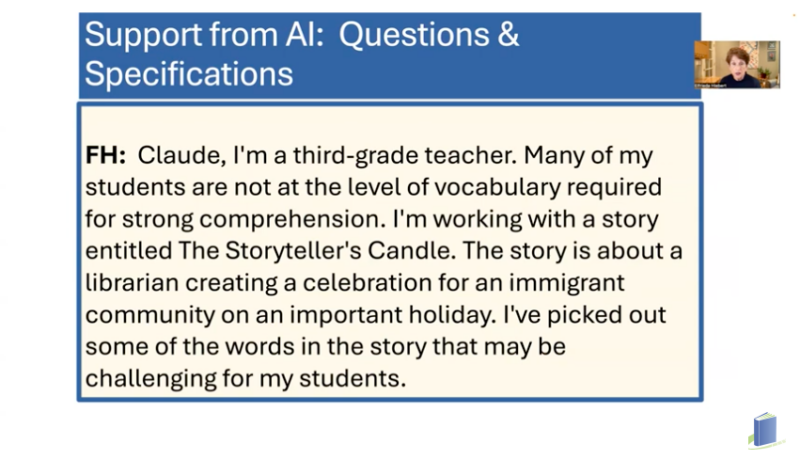
In both her webinar and her follow-up video, “Using AI to Teach Word Networks,” Dr. Hiebert reviewed how she asks AI to narrow down the highest-value words for third graders from a list of possibilities from the picture book The Storyteller’s Candle by Lucia Gonzalez. She started by sharing the context above, and then added, “Can you help me in identifying which of these words are ones that may be challenging for students but are also words that will extend beyond third grade and support their reading in the middle grades and beyond?” Then she provided a list of potential words from the book.
Claude quickly provided insight that the words preparations, concluded, announcement, event, celebrated, and donations would serve as “high-value” words that would be both challenging and academically valuable to third graders in other contexts.
AI can also help choose vocabulary words to emphasize to build students’ background knowledge about a certain topic. To the prompt above, Dr. Hiebert added, “I also want to help my students’ background knowledge on what is part of a performance, like a play or cultural events.” She immediately got back a curated list for this topic with the words rehearsed, characters, costumes, applause, decorations, fiesta, celebrated, and event.
Dr. Hiebert advocates approaching vocabulary learning with the goal of helping students build “collections” of words they know. This approach helps kids both deepen their understanding of word meanings and retain them. AI can quickly help teachers create lists of connected words and create visuals about word relationships.
Organize words by concept
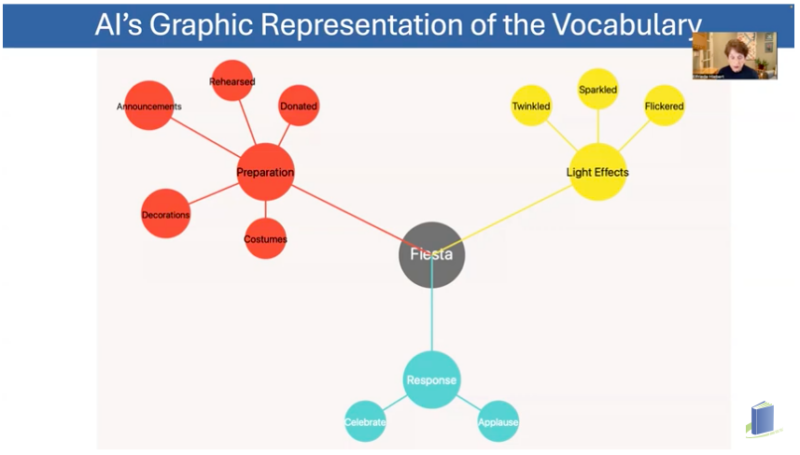
In a blog post, Dr. Hiebert showed how AI can quickly group words from a list into meaning-based categories. These turned out to be “actions of a candle,” “preparations for a celebration,” and “features of a celebration.” In her “Using AI To Teach Word Networks” video, Hiebert shows how she used AI to create a visual to conceptually organize a set of words from The Storyteller’s Candle. These conceptual categories were: preparation, light effects, and responses, as related to a fiesta. It’s easy to imagine as teachers how any of these categories could help students better “collect” relationships between words to improve their vocabulary knowledge.
Show multiple meanings of words
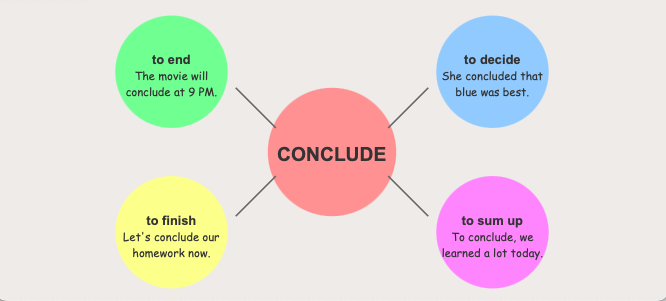
AI can also help create visuals to explore multiple meanings of words. Inspired by Dr. Hiebert’s prompts, we requested from Claude: “I’m a third grade teacher. Please make a graphic organizer that explains the multiple meanings of the word concluded. Please make it colorful.” Claude delivered with an easy-to-use word web.
Show morphological relationships of words
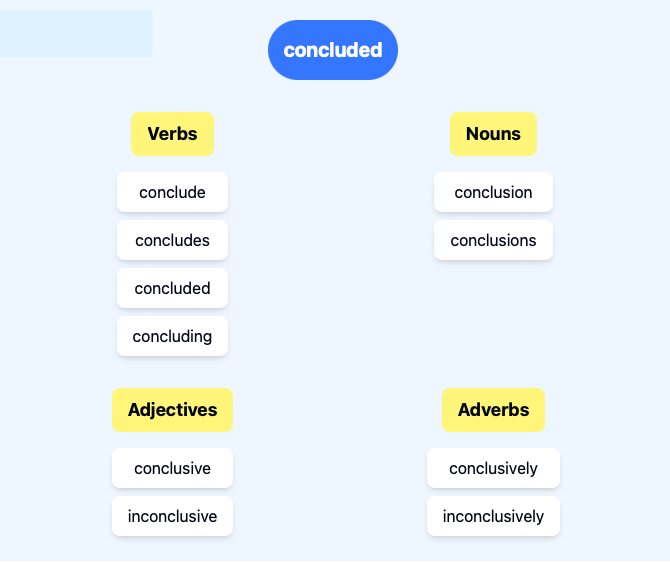
Looking at words that are morphologically related to a target vocabulary word—words that share meaningful word parts— both deepens kids’ understanding and adds new words to their knowledge base. Dr. Hiebert encourages teachers to use AI to easily generate lists and create visuals for morphologically related words. “Concluded” was one of the high-value words her AI prompts identified from The Storyteller’s Candle. We prompted Claude: “I’m a third grade teacher. Please make a web graphic organizer showing all the morphological relatives of the word ‘concluded,’ organized by parts of speech.” Once again, we got a ready-made slide to discuss with kids without having to rack our own brains!
Explore words with similar meanings
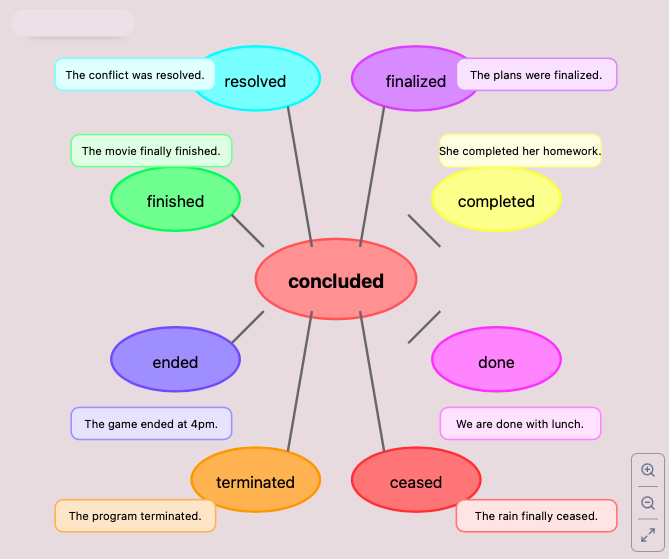
We can also use AI for vocabulary instruction around words with related meanings, or words within the same “semantic family.” Again taking cues from Dr. Hiebert’s prompts, we asked Claude: “I’m a third grade teacher. Please make a graphic organizer that introduces kids to words in the same semantic family as ‘concluded.’ Please make it colorful.” The first result we got included words that felt too easy, so we added, “Keep this graphic, but add 4 more words that may be a bit challenging for third grade readers. Choose words they are likely to see in their future reading and academic tasks.” The result? A quick and easy visual to reinforce the meanings of “concluded” and introduce kids to some more nuanced related words.
3. Create your own “AI-assisted” texts and worksheets
Much of Dr. Hiebert’s work hinges on the idea that the more often kids encounter a vocabulary word, the more they can build knowledge of the word and automaticity reading it. Writing additional texts and designing activities for kids that include target words is a great way to increase their exposure to those words. However, if your mind regularly goes blank when you attempt this kind of thing, AI has your back once again. In her webinar, Dr. Hiebert shared many ideas for using AI for vocabulary-driven student texts and worksheets. Here are some prompts that we used, inspired by her directions, and our results:
New texts with target words
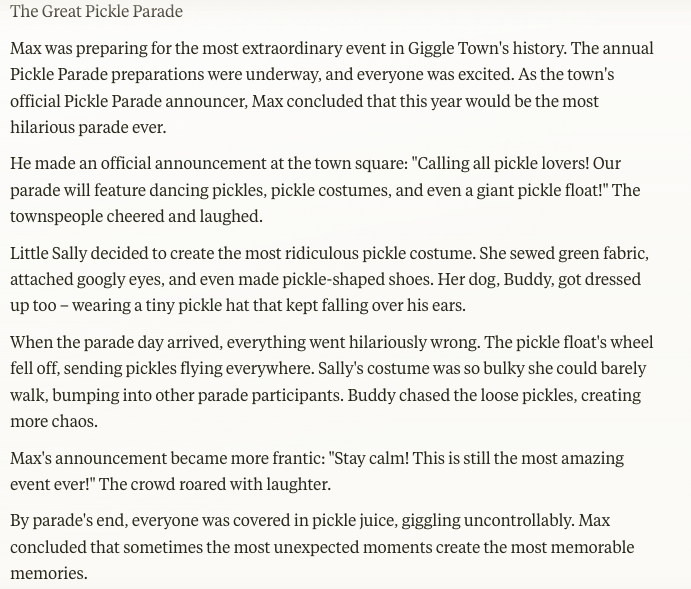
We asked Claude: “Can you please write a funny story that is around 250 words long for third grade students? Include the words event, preparations, concluded, and announcement (and their morphological relatives). Repeat each word at least twice if possible.” The result was … pretty good! You could easily adjust the length, difficulty, and topic with additional prompts. (Bonus tip: To find tons of ready-made student texts organized by topic that include repeated exposures to high-value vocabulary words, definitely check out Dr. Hiebert’s site TextProject.)
Fill-in-the-blank worksheets
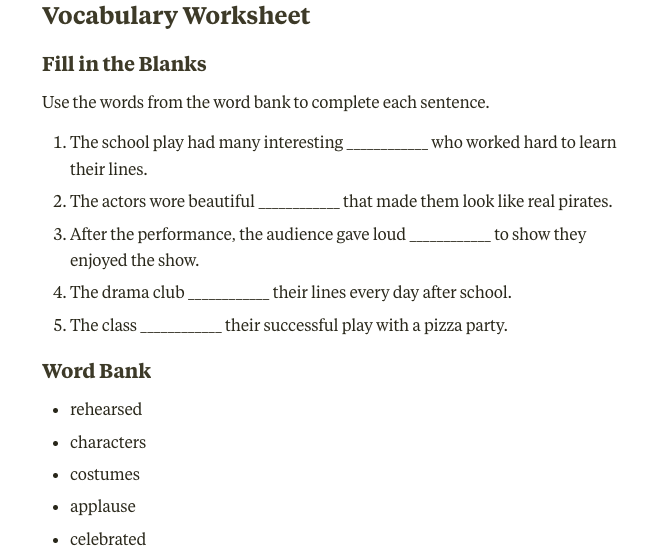
There are tons of possibilities for using AI to create worksheets to reinforce vocabulary learning. We asked Claude, “Can you please create a worksheet for third grade students with fill-in-the-blank sentences in which the words rehearsed, characters, costumes, applause, decorations, celebrated, and event fit? Include a word bank at the bottom with the vocabulary words.” Again, the result is a great starting place and could be tweaked with additional feedback or offline editing.
Sentences to draw or act out
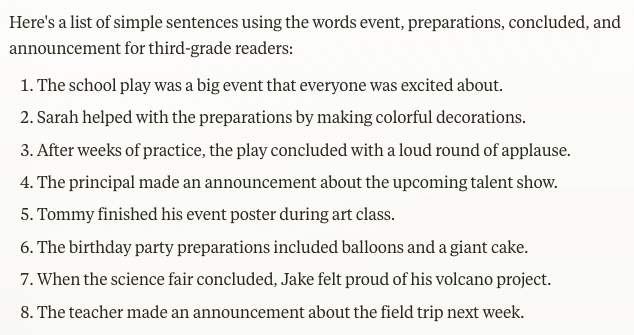
We often ask kids to write sentences with vocabulary words, but reading and reflecting on the meaning of additional sentences are other worthwhile exercises. And, you guessed it, AI can do a lot of the prep work for you. We asked, “Claude, would you please create a list of sentences with the words event, preparations, concluded, and announcement for third grade readers that will be easy for them to act out or illustrate?” The results definitely got us going on the right track.
As with any time you use AI, your teacher’s eye will be essential for review. But having to perform thoughtful editing is much faster and easier than having to start from scratch.
Looking for more articles like this? Subscribe to our newsletters to find out when they’re posted!
Source link




